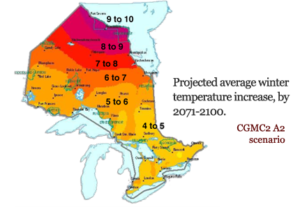Climate Change
How can we help our forests adapt to Climate Change?
Climate change is happening now and is predicted to significantly affect our forests, and therefore our landscape and our society. How are forests adapting to Climate Change?
Providing strategic forest management advice and facilitating assisted migration.
Climate Change Adaptation
The resiliency of our forests depends on interactions among plants and animals, the quantity and quality of forests, as well as human and natural disturbance. These elements combined can have an impact on the genetic fitness and diversity of our forests. Our forests are diverse in species, but each species is also made up of unique, locally adapted individuals and populations. So, any plan to adapt to climate change must incorporate genetic fitness and diversity at all levels.
Find out How Organizations in Ontario are tackling these complex problems.
Woody Plant Seed Collection Guidelines for a Changing Climate
Vulnerability of Tree Species to Climate Change

Projected changes in climate conditions over the next century vary widely across Canada, and so does the capacity of forest species to cope. However, not all species will react equally in the face of rapid environmental change. As part of the Forest Change project of Natural Resources Canada, a series of comparative indices of sensitivity and ability to adapt were developed for 26 species found in Ontario and Eastern Canada to better understand how species respond to climate stress and how local management decisions can be taken to mitigate impacts.
For more information about this work see the Vulnerability of Tree Species to Climate Change website.
Assisted Migration
Our forest’s capacity to adapt, thrive and provide the many benefits our society needs, depends on informed restoration and forest management plans.
Ontario’s forests also depend on successful forest management programs and initiatives in the United States, as many species we work with and rely on have southern populations for ideal seed sourcing for Climate Change adaptation efforts.
Go to our Assisted Migration page now
Climate Change Resources
- Northern Institute of Applied Climate Science – Adaptation Workbook
- Natural Resources Canada – Forest Change Adaptation Tools
- Natural Resources Canada – Forest Vulnerability Assessment Tool
- Natural Resources Canada – Plant Hardiness Website
- NDMNRF (formerly MNRF) – Ontario Tree Seed Transfer Policy Tool
- Ontario Resources Centre for Climate Adaptation (orcca)
- Learn about Ontario’s forest research programs
- Ontario Forest Research Institute – Impacts of climate change on Ontario’s forests
- US Seedlot Selection Tool
- US Climate Change Tree Atlas
- Sign up for the Forestry Adaptation Community of Practice for webinars, research papers and news
